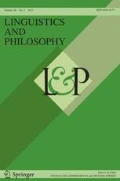Abstract
We offer a formal account of the English past tenses. We see the perfect as having reference time at speech time and the preterite as having reference time at event time. We formalize four constraints on reference time, which we bundle together under the term ‘perspective’. Once these constraints are satisfied at the different reference times of the perfect and preterite, the contrasting functions of these tenses are explained. Thus we can account formally for the ‘definiteness effect’ and the ‘lifetime effect’ of the perfect, for the fact that the perfect seems to ‘explain’ something about the present, and that the perfect cannot presuppose a past time point. We explain why perfect and preterite can sometimes be interchangeable, and we offer a solution to the ’present perfect puzzle’. We explain the unacceptability of notorious examples of the perfect such as *Gutenberg has discovered the art of printing. We give greater definition to the familiar notions of ‘current relevance’ and ‘extended now’.
Similar content being viewed by others
References
Binnick R. (1991) Time and the verb: A guide to tense and aspect. Oxford University Press, Oxford
Bryan W. (1936) The preterite and the perfect tense in present-day English. Journal of English and Germanic Philology 35: 363–338
Chomsky N. (1970) Deep structure, surface structure, and semantic interpretation. In: Jakobson R., Kawamoto S. (eds) Studies in general and oriental linguistics. TEC Corporation, Tokyo, pp 52–91
Comrie B. (1976) Aspect. Cambridge University Press, Cambridge
Curme G.O. (1935) A grammar of the English language, volume 2: Parts of Speech and Accidence. D.C. Heath, New York
Declerck R. (1991) Tense in English: Its structure and use in discourse. Routledge., London
Dietrich W. (1955) Erweiterte form, Präteritum und Perfektum im Englischen Eine Aspekt- und Tempusstudie. Hueber, Munich
Dowty D. (1977) Toward a semantic analysis of verb aspect and the English continuative progressive. Linguistics and Philosophy 1: 45–77
Dowty D. (1979) Word meaning and montague grammar: The semantics of verbs and times in generative semantics and in Montague’s PTQ. Reidel, London
Heim, I. (1982). The semantics of definite and indefinite noun phrases in English. PhD Thesis, University of Massachusetts, Amherst.
Higginbotham J. (2009) Tense, aspect and indexicality. Oxford University Press, Oxford
Iatridou, S., Anagnostopoulou, E., & Pancheva, R. (2001). Observations about the form and meaning of the perfect. In M. Kenstowicz (Ed.), Ken Hale: A life in language (pp. 189–238). Cambridge: MIT.
Inoue K. (1979) An analysis of the English present perfect. Linguistics, an Interdisciplinary Journal of the Language Sciences 17: 561–589
Kamp H., Reyle U. (1993) From discourse to logic. Kluwer, Dordrecht
Kiparsky, P. (2002). Event structure and the perfect. In D. I. Beaver, L. D. C. Martinez, B. Z. Clark, & S. Kaufmann (Eds.), The construction of meaning. Stanford: CSLI Publications.
Klein W. (1992) The present perfect puzzle. Language 68(3): 525–552
Klein W. (2000) An analysis of the German Perfekt. Language 76(2): 358–382
McCawley J.D. (1971) Tense and time reference in English. In: Fillmore C.J., Terence Langendoen D. (eds) Studies in linguistic semantics. Holt, Rinehart and Winston, New York, pp 96–113
McCoard R.W. (1978) The English perfect: Tense-choice and pragmatic inferences. North-Holland, Amsterdam
Michaelis L. (1994) The ambiguity of the English present perfect. Journal of Linguistics, 30: 111–157
Mittwoch A. (1988) Aspects of English aspect: On the interaction of perfect, progressive and durational phrases. Linguistics and Philosophy 11: 203–254
Moens M., Steedman M. (1988) Temporal ontology and temporal reference. Computational Linguistics, 14(2): 15–28
Musan R. (1997) Tense, predicates, and lifetime effects. Natural Language Semantics 5: 271–301
Musan R. (2002) The German perfect Its semantic composition and its interaction with temporal adverbials. Kluwer, Dordrecht
Pancheva R., von Stechow A. (2004) On the present perfect puzzle. In: Moulton K., Wolf M. (eds) Proceeding of the North East Linguistics Society (=NELS) 34. Amherst, GLSA
Partee B. (1973) Some structural analogies between tenses and pronouns in English. The Journal of Philosophy 70(18): 601–609
Pickbourn J. (1789). A dissertation on the English verb (Facsimile edition, 1968). Menston, Scolar Press
Portner P. (2003) The (temporal) and (modal) pragmatics of the perfect. Linguistics and Philosophy 26: 459–510
Portner, P. (2011). Perfect and progressive. InC.Maienborn,K. vonHeusinger,&P.Portner (Eds.), Semantics: An international handbook of natural language meaning. Berlin:Mouton de Gruyter. Available at http://semanticsarchive.net/Archive/jlmMTE0M/Portner-perfect-progressive-HSKdraft.pdf. Accessed 23 Nov 2011.
Reichenbach, H. (1947). Elements of symbolic logic. London: Macmillan. (Repr. Dover, New York, 1980.)
Rothmayr A. (2009) The structure of stative verbs. Benjamins, Amsterdam
Rothstein B. (2008) The perfect time span: On the present perfect in German, Swedish, and English. John Benjamins, Amsterdam
Smith C. (1997) The parameter of aspect (2nd ed). Kluwer, Dordrecht
Schaden G. (2009) Present perfects compete. Linguistics and Philosophy 32(2): 115–141
Vendler Z. (1967) Linguistics in philosophy. Cornell University Press, New York
von Stechow A. (1999) Eine erweiterte Extended Now Theorie fü r Perfekt und Futur. Zeitschrift für Literatur und Linguistik 113: 86–118
Author information
Authors and Affiliations
Corresponding author
Rights and permissions
About this article
Cite this article
Meyer-Viol, W.P.M., Jones, H.S. Reference time and the English past tenses. Linguist and Philos 34, 223–256 (2011). https://doi.org/10.1007/s10988-011-9100-y
Published:
Issue Date:
DOI: https://doi.org/10.1007/s10988-011-9100-y


